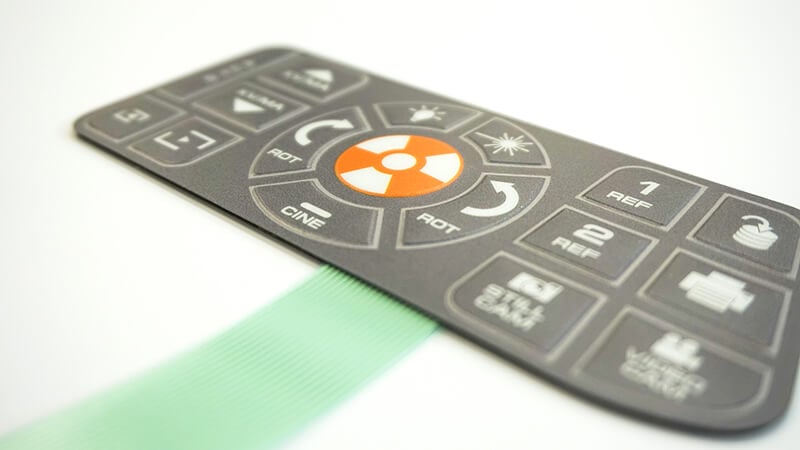The Function of a Membrane Switch in Modern Touch Interfaces and Controls
The Function of a Membrane Switch in Modern Touch Interfaces and Controls
Blog Article
Recognizing the Capability of Membrane Layer Switches for User Interface Tools
The performance of membrane switches stands for a substantial improvement in interface design, integrating efficiency with aesthetic flexibility. These buttons run with a multi-layered structure that translates user communications right into electric signals, permitting both small designs and durability versus environmental aspects. As sectors increasingly focus on user experience, understanding the subtleties of membrane switch modern technology comes to be important. What ramifications do these developments hold for future applications, and exactly how might they redefine user communications across numerous tools?
What Are Membrane Layer Buttons?
Membrane layer buttons are cutting-edge interface devices that assist in user interaction with electronic tools. These versatile parts are composed of multiple layers, consisting of a visuals overlay, spacer, and a published circuit layer. The style enables for a smooth assimilation into various electronic gadgets, boosting both the visual and useful facets of interface.
Membrane layer switches are typically used in a large range of applications, from household appliances to industrial equipment and medical devices. Their building normally includes a thin account, making them an excellent option for portable styles. The tactile feedback provided by these buttons can be crafted to satisfy particular individual choices, ensuring efficient communication between the user and the device.
Resilience is one more substantial advantage of membrane layer buttons, as they are immune to dirt, dampness, and chemicals, which enhances their life-span popular settings. Furthermore, these buttons can be personalized in regards to shape, size, and graphic design, permitting branding and user-specific attributes. Generally, membrane layer switches over represent a practical remedy for improving individual experience in electronic gadgets, combining functionality with visual allure in an effective fashion.
Just How Membrane Layer Changes Job
Operating on a straightforward concept, membrane changes use a split building and construction to register user input properly. Each button is composed of several layers, consisting of a printed circuit layer, a spacer layer, and a leading visuals layer, which are designed to function with each other effortlessly. When a user presses the top layer, it presses the spacer layer, bringing the conductive aspects of the circuit layer into contact with each other.
This call produces a closed circuit, signaling the device to execute a details feature. The layout enables different setups, consisting of tactile responses, which can enhance the individual experience by giving a physical sensation upon activation. The products utilized in membrane buttons often consist of adaptable substrates, such as polyester or polycarbonate, which ensure longevity and resilience against damage.

Key Benefits of Membrane Layer Switches

One more substantial advantage is their density. Membrane buttons are slim and lightweight, which makes it possible for manufacturers to conserve area in their tools without sacrificing capability. This feature is especially helpful in applications where weight and volume are vital considerations.
In addition, membrane layer buttons are resistant to dust, moisture, and chemicals, enhancing their resilience. This resilience prolongs their lifespan and minimizes the demand for regular replacements, causing cost financial savings gradually.
Additionally, the tactile feedback supplied by membrane layer buttons can be maximized to enhance customer interaction. They can consist of functions such as increased switches or distinct clicks, enhancing functionality and individual experience.
Applications Throughout Industries
Individual interface gadgets utilizing membrane switches are prevalent in a large range of industries, showcasing their flexibility and performance. Membrane Switch. In the clinical industry, membrane buttons are important to devices such as diagnostic tools and person surveillance discover this systems, where their toughness and ease of cleaning are important for maintaining hygiene requirements. In the auto industry, these switches are employed in control panel controls and infotainment systems, giving a sleek and modern interface for individuals.
In addition, the customer electronic devices market gain from membrane buttons in devices and portable tools, where compact layout and straightforward interfaces enhance individual experience. Industrial applications additionally leverage membrane layer switches for control panels in equipment and automation systems, highlighting their effectiveness and resistance to extreme environments.
In the aerospace and defense markets, membrane layer switches are used in cockpit controls and tools, where reliability and efficiency under severe conditions are extremely important. Additionally, the pc gaming industry significantly includes membrane switches in controllers and gallery devices, adding to an appealing user experience. Overall, the versatility of membrane switches allows their widespread usage across countless fields, underscoring their importance in contemporary interface layout.
Future Patterns in Membrane Layer Change Technology

Additionally, using sophisticated products, such as polycarbonate and polyester movies, is expected to rise, providing improved resilience and resistance to ecological stress factors. These products contribute to the general durability of membrane buttons, making them suitable for harsher commercial applications.
Moreover, the unification of smart modern technology, consisting of IoT connectivity, will enable membrane switches to connect with other devices and systems, assisting in a much more interactive customer experience. This trend straightens with the growing demand for smart tools across various markets, from health care to consumer electronic devices.
Finally, modification options are expected to broaden, permitting producers to create bespoke services customized to particular individual requirements and preferences. These advancements will certainly position membrane layer switches as crucial components in the advancement of interface modern technology.
Verdict
In verdict, membrane layer changes represent an essential official site advancement in individual interface innovation, providing a trusted and functional service for varied digital applications. As advancements in product science and touch sensing technologies continue, the performance and applicability of membrane buttons are expected to broaden, reinforcing their relevance in modern-day electronic gadgets.
Report this page